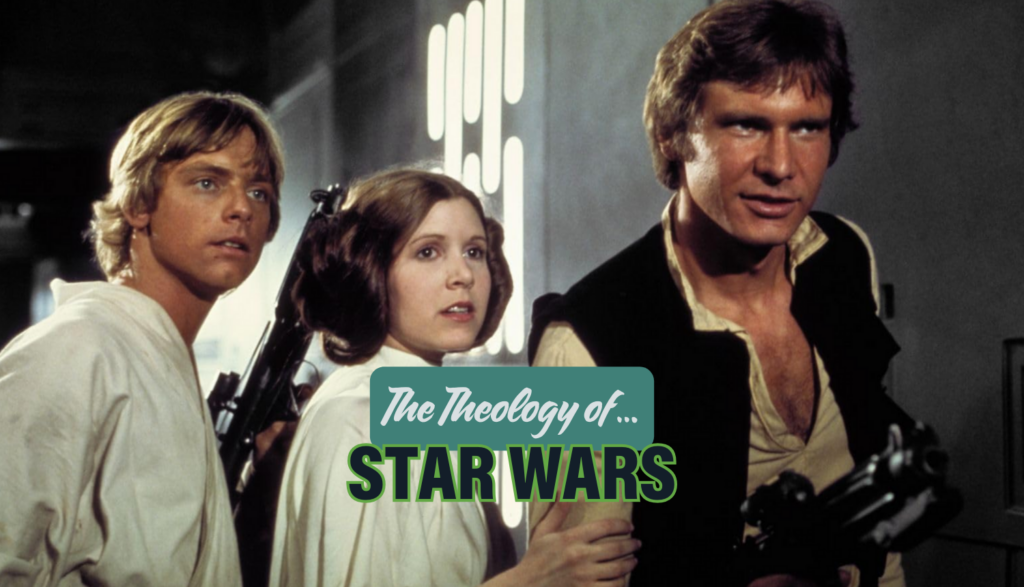The Theology Of … is a series in which we tell parents about the overt or subtle spiritual worlds of various popular media. Each article will explain the theological landscape of a relevant series, and when appropriate, we’ll provide ways for parents to use said content as a way to teach their child about Christian theology.
Introduction to the Series
The universe got a lot bigger on May 25, 1977.
That was the day the world was exposed to Star Wars, George Lucas’ space epic that would go on to capture so many hearts that the series fanbase is still strong enough for Disney+ adaptations today. With the original trilogy commencing in 1977, the prequel trilogy launching in 1999 and a sequel trilogy kicking off in 2015, three generations have now grown up alongside new franchise releases.
It’s an age where not having seen a Star Wars film may very well be a minority position. The same might be said for someone who hasn’t heard terms like lightsaber or Millennium Falcon. But despite a culture heavily saturated in all things Star Wars, the franchise’s spiritual themes might not be as quickly understood by the majority of viewers.
For instance, everyone knows that the Force lets you telekinetically push things and do that finger wave that makes people agree with you, but what are the implications of such a Force, spiritually speaking? We’ll explore that question and more.
So, without further ado, hop into your favorite spaceship as we take off to explore the most prominent spiritual messages in Star Wars in less than 12 parsecs.
Note: Because Star Wars is an expanded universe, it would take a much bigger blog post than this to cover all of the spiritual implications and realities found within. As such, The Theology of Star Wars will only consider events within the 12 Star Wars films. Any references to other Star Wars properties are merely to help explain ideas present within the franchise films.
Overarching Spiritual Worldview
Throughout the galaxy are dozens of sentient alien species, including humans. And though these creatures can all look vastly different, from hair-covered Wookiees to the slug-like Hutts, they all have something in common: midi-chlorians. These intelligent, microscopic life-forms live within the cells of all living things. And it’s these midi-chlorians that allow certain people with higher quantities of them to detect and interact with a mysterious energy known as the Force.
Those capable of using the Force through rigorous training are able to appropriate its power. Since midi-chlorians are connected to the Force, those who use the Force are able to exert varying degrees of power over others, such as telekinetically pushing or pulling them or even manipulating their minds. Those particularly connected to the Force can even discern that it contains a will of its own for the universe, and these Force-sensitive users will often submit themselves to its predestined will.
The two most prominent groups of Force users within the Star Wars movie franchise are known as the Jedi and the Sith. This split is due to the dualistic nature of the Force, as it could be channeled in one of two ways: toward a “light side” and toward a “dark side.” The Jedi dedicated themselves to serving the will of the light side of the Force, which emphasized compassion and peace through clearing the mind, clinging to calm emotions and disposing of attachments—spiritual practices that historically have been associated with Buddhism and some expressions of Hinduism.
Meanwhile, the Sith devote themselves to the dark side of the Force, which involves indulging strong emotions such wrath and hatred. Those who utilize the dark side, acting against the will of the Force, have historically threatened to destroy the balance of the Force—that is, to prevent the proper order of things, wherein the light side keeps the dark side in check.
These diametrically opposed and dualistic views between the Jedi and Sith mean that the galaxy is engulfed in a constant struggle between light and darkness, good and evil, as Jedi and Sith continuously clash.
This clash comes to a head when young Anakin Skywalker is discovered. Thanks to his connection to the will of the Force, one ancient Jedi had prophesied that “a Chosen One shall come, born of no father, and through him will ultimate balance in the Force be restored,” according to the Star Wars novel “Master and Apprentice.”
Anakin was determined to be fulfill this prophecy, as he was born of no father and had a higher midi-chlorian count than anyone had ever recorded before. And though things don’t go the way the Jedi expected, Anakin does eventually bring balance to the Force by defeating Emperor Palpatine, bringing the dark side back into check.
Glossary of Important Characters/Topics
Anakin Skywalker – Anakin is the “Chosen One” prophesied to bring balance to the Force. He is slowly corrupted by Emperor Sheev Palpatine, however, and he eventually turns to the dark side. He’s defeated by his master, Obi-Wan Kenobi, and the injuries he sustains in that battle force him to remain in special life-preserving armor for the rest of his life. Following the fight, he is dubbed Darth Vader by Palpatine. At some point, Anakin learns that Luke is his son, as he had previously assumed his preborn children had died along with wife Padmé, and he plans to overthrow Palpatine so he can rule the galaxy with Luke. But when Palpatine electrocutes Luke in an attempt to kill him, Anakin gives his life to save his son, thereby fulfilling the Chosen One prophecy with his and Palpatine’s deaths.
Luke and Leia Skywalker – Luke and Leia are the children of Anakin and his wife, Padmé. After they were born, Jedi such as Obi-Wan and Yoda discussed what to do with the children, agreeing that they should be split up in order to protect them. As Luke grows older, he learns much about his heritage, and he is eventually trained as a Jedi. Luke and Leia both eventually reunite and align with the Rebels in the fight against the Empire (a totalitarian government led by Palpatine). Later, the two train up other soldiers to fight when, somehow, Palpatine returns.
Obi-Wan Kenobi – Obi-Wan is a Master Jedi, a teacher and mentor in the ways of the Jedi code of conduct and of the Force. He is also Anakin’s master. Obi-Wan first encountered Anakin when the boy was a slave on the desert planet Tatooine. Obi-Wan and his master, Qui-Gon Jinn, discover that has a higher midi-chlorian count than any Jedi in existence. They believe that Anakin is the Chosen One spoken about in Jedi prophecy—someone who will bring balance to the Force. Obi-Wan and Anakin eventually spar following Anakin’s turn to the dark side. Much later, Obi-Wan briefly trains Luke Skywalker in the ways of the Jedi as well.
Sheev Palpatine – Palpatine (also known secretly as Darth Sidious) was originally the senator of the planet Naboo and made many political plays in order to rise to power as the Supreme Chancellor and later, the Galactic Emperor. He orchestrates Order 66, a contingency plan that forced clone soldiers to turn on Jedi, killing most of them and collapsing the Jedi Order. He manipulates Anakin Skywalker into becoming his apprentice, luring him with stories of being able to use the Force to grant his loved ones immortality. Palpatine is later defeated when Anakin eventually turns against him in order to save his son. However, utilizing the aforementioned secrets to immortality, Palpatine would transfer his consciousness and spirit into a clone body before being defeated again in the sequel trilogy by Rey Skywalker.
Jedi – The Jedi (sometimes called Jedi Knights) seek to protect peace through their special connection to the Force. They utilize methods that emphasize the light side of the Force, the side which deals in “calmness, peace, and passiveness, and was used only for knowledge and defense,” according to Wookieepedia, a Star Wars fan information site. Jedi are typically adherents to the Jedi Order, a nontheistic religious order with a Grand Temple led by 12 Jedi Masters (the highest level in the Order) who serve on a high council. Jedi typically strive to follow the Jedi Code, a set of rules which dictate how a Jedi should live. One of the most important of these rules includes not becoming attached to anything, lest negative emotions should arise, cloud judgment and lead the Jedi to the dark side. The vast majority of Jedi are wiped out following Order 66.
Sith – In contrast to the Jedi, the Sith are an order which emphasizes the dark side of the Force. They encourage giving into emotions like anger and hate, since they believe these dark passions make them stronger. And while dark side is considered to be an easier path to follow, its power is significantly more difficult to control. Thus, the Jedi generally believe that anyone who gives into the dark side never fully recovers.
The Force – The Force is “what gives a Jedi his power,” Obi-Wan Kenobi tells Luke Skywalker early in Star Wars: Episode IV – A New Hope. “It’s an energy field created by and connecting all living things. It surrounds us, it penetrates us, it binds the galaxy together.” While all people manifest some trace of the Force, some are able to better sense and even use it due to having higher than average midi-chlorian counts in their bloodstreams.
The two methods of utilizing the Force are known as the “light side” and the “dark side.” A more specific part of the Force, known as the Cosmic Force, even has a will to which those who clear their minds can tap into and discern. Jedi strive to “become one” with the Force, and at death, their life force then can “return to the embrace of the Cosmic Force.” Because the Force is everywhere and connects all lifeforms, some could likewise become “Force Sensitive” and supernaturally detect strong emotions as well as mentally manipulate others, telekinetically push and pull or even see visions of the future. The Force allows those who are sensitive to it to discern where future attacks will come from, enabling them to block or dodge laser blasts and lightsaber strikes.
Midi-chlorians – Midi-chlorians are microscopic, sentient lifeforms within the cells of all living organisms, and they are the means by which humanoids can detect and utilize the Force.
Death Star – The Death Star is a massive superstructure controlled by the Empire that is capable of destroying entire planets in a single, charged-up laser blast. It is described as being roughly the size of a moon. The Death Star (and others like it) poses a significant threat in several Star Wars films.
Connecting, and Contrasting, the Gospel
You have probably picked up on a few themes that connect and contrast with Christianity. For instance, Anakin having something like an “immaculate conception” without a human father as well as the 12 Jedi who speak into the religion certainly, at face value, mimic Jesus being conceived of the Holy Spirit and the 12 disciples. However, Star Wars is likewise syncretized with religion that follows a much more Buddhist perspective, too. Below are a few ways you might consider bringing up the gospel while watching Star Wars.
- Dualism – In Star Wars, the Jedi and the Sith battle each other as two ideologies competing for supremacy. And while the light side of the Force ultimately triumphs in the films, the dark side has the legitimate potential to utterly destroy the light side. In other words, if Jedi like Luke and Rey fail in their missions, evil can finally and ultimately win. Both sides are, potentially, equally powerful. But this Buddhist-informed dualism (think the popular, circular yin-yang symbol) contrasts with the Christian view of good and evil, in which there is no dualistic view. Though Satan and evil exist, they are not equal to God and His goodness in power, and they cannot and will not triumph in the end (Genesis 3:15, Matthew 16:18-19, Revelation 12:10-12). Satan is subservient to God, and he has no chance of succeeding in his schemes (Job 1:6-12, Luke 22:31-32, John 12:31). Jesus has delivered us from the evil one and has justified all who believe in Him through His death, burial and resurrection (Colossians 1:15-23).
- Emptying the Mind – Much of Jedi thought mirrors an Eastern way of thinking. Specifically, Jedi are encouraged to remove themselves from strong emotion and from their attachments, as such things only lead to the wicked path of the dark side of the Force. They are further encouraged to empty their minds in order to better hear and follow the will of the Force. While the Bible does teach that attachments can become idols that distract us from the Lord and that attachment to worldly desires is sinful (Colossians 3:1-11, Titus 2:11-12, 1 John 2:16), we are never called to abandon such things in the Eastern sense of ascetism. For example, while Eastern meditation focuses on emptying the mind, Christian meditation centers on filling the mind with thoughts of God, His law and His glory (Psalm 145:5). While Eastern desire is seen as evil, Christians are called to desire the things of God (Psalm 37:4 and 73:25, for instance). In fact, through God’s sanctification of the Christian, we are actively being transformed into the same image of the Lord from one degree of glory to another (2 Corinthians 3:18).
- Inherent Sin – Though Jedi are devoted to the light side of the Force, they’re also taught that they must be mindful that everyone, including the Jedi themselves, have some dark side inside of them that they must keep in check lest it dominate them. They must cling to the good and be mindful of that which would cause them to indulge in the dark side of the Force. This can compare to the Christian life, too. A Christian is washed and redeemed by the blood of Christ and is called to strive to live a good, godly life (1 Corinthians 6:11, Ephesians 4:1-6, Hebrews 10:19-25). However, Christians are likewise called to wage war against the sinful desires still present within us (Romans 7:21-25, Galatians 5:17). If Christ has redeemed you, you are called to live in the things of the Spirit and not the things of the flesh (Romans 8:1-11).
Conclusion
As with any huge franchise, there are more details (especially as relate to the ongoing Disney+ Star Wars series) that we could unpack. But this overview should give you and your family a foundation for thinking critically about this influential franchise from a Christian point of view. We hope that this serves as a helpful primer for parents looking to understand the spirituality presented in Star Wars—whether as a way to inject a gospel conversation or decide whether the franchise is for them.








4 Responses
Good timing for this since the first Star Wars: Knights of the Old Republic game is free/complementary to play on Nintendo Switch for online subscribers until late next week, so a new generation of gamers will be able to forge their own moral destinies—this being one of the first “made for a console” RPGs I remember offering non-linear moral choices—with all of the implications that brings.
To the people at PluggedIn, have you ever considered writing articles about the theologies of “The Matrix”, “Harry Potter”, “The Chronicles Of Narnia”, “The Hobbit” or “The Lord Of The Rings”?
Hi! We’ve actually got a large list of franchises that we’re considering for Theology of blogs, ranging from video game franchises to TV shows and movies. You’ll be happy to know that all of the titles you’ve listed are on that list, and we’ve actually already written one on the Lord of the Rings, which you can find here. Thanks for the suggestions!
You should do ones about the Marvel Cinematic Universe, the Christopher Nolan Batman trilogy, and the Sam Raimi Spider-Man trilogy!